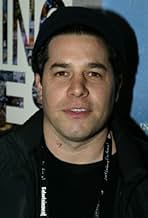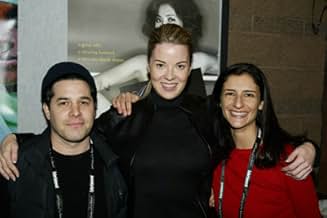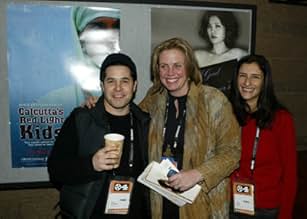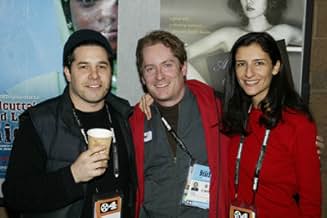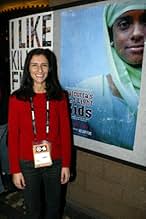IMDb रेटिंग
7.2/10
18 हज़ार
आपकी रेटिंग
अपनी भाषा में प्लॉट जोड़ेंTwo documentary filmmakers chronicle their time in Sonagchi, Calcutta and the relationships they developed with children of prostitutes who work the city's notorious red light district.Two documentary filmmakers chronicle their time in Sonagchi, Calcutta and the relationships they developed with children of prostitutes who work the city's notorious red light district.Two documentary filmmakers chronicle their time in Sonagchi, Calcutta and the relationships they developed with children of prostitutes who work the city's notorious red light district.
- 1 ऑस्कर जीते
- 21 जीत और कुल 5 नामांकन
Zana Briski
- Self "Zana Auntie"
- (बिना क्रेडिट के)
Sunil Halder
- Self
- (बिना क्रेडिट के)
- …
फ़ीचर्ड समीक्षाएं
I often disagree with the academy award nominations. It's usually too political to nominate the best movies and performances of the year. Born Into Brothels is an exception, it was nominated and won! The only mistake was not nominating it for best picture.
Brothels is the story of a woman, Zana Briski, who traveled to Calcutta to photograph the brothels. She fell in love with the children and began teaching them photography. The movie is seen through their eyes.
The result is extraordinary in so many ways. Calcutta's red light district is interesting in and of itself. The setting is the first extraordinary feature. The filming makes you feel like you are there. Director Ross Kauffman captures the feeling of being trapped in dark allies with a dark future. Without a director commentary running though the film, you're able to see it all by the way it's been directed. The dark past and future of these families is presented in a beautiful and horrific way.
Secondly, the children are lovable. The story focuses on 8 or 9 children of prostitutes. Each one is unique. Some are incredibly funny, others serious, some are troubled, and at least one has an undeniable talent for photography. You'll leave the theater feeling like you know them.
This is documentary film at its best. It transports us to another country and makes us love the troubled children. What was troubling to me was having to leave the theater never to see these troubled children again. Putting aside the incredible movie-making abilities of these creators, Zana Briski is a true hero.
Brothels is the story of a woman, Zana Briski, who traveled to Calcutta to photograph the brothels. She fell in love with the children and began teaching them photography. The movie is seen through their eyes.
The result is extraordinary in so many ways. Calcutta's red light district is interesting in and of itself. The setting is the first extraordinary feature. The filming makes you feel like you are there. Director Ross Kauffman captures the feeling of being trapped in dark allies with a dark future. Without a director commentary running though the film, you're able to see it all by the way it's been directed. The dark past and future of these families is presented in a beautiful and horrific way.
Secondly, the children are lovable. The story focuses on 8 or 9 children of prostitutes. Each one is unique. Some are incredibly funny, others serious, some are troubled, and at least one has an undeniable talent for photography. You'll leave the theater feeling like you know them.
This is documentary film at its best. It transports us to another country and makes us love the troubled children. What was troubling to me was having to leave the theater never to see these troubled children again. Putting aside the incredible movie-making abilities of these creators, Zana Briski is a true hero.
It would certainly take a filmmaker of much self-consciousness, something which Zana Briski certainly possesses, to make this film the way she has. Having met with uncooperative roadblocks to shooting a documentary about sex-workers and their families within the squalid confines of Calcutta's red-light district, Briski states early on that she decides to have the children themselves tell their story by supplying them with automatic cameras to use in their own personal ways. The film, however, ultimately becomes an account of one outsider's attempt to save these children from their miserable fates - poverty and sexual abuse. With the children's sex-worker mothers and families, many of whom have apparently spent generations in the district with no escape in sight, used as background elements, Briski focuses solely on the children, entering them into an informal photography seminar where they gather to share contact sheets of their pictures and discuss the problems of shooting amidst uncooperative and hostile subjects and why certain pictures work and why some don't. Thankfully, Briski also interviews the children, and while it's not clear they understand her theories on picture composition, they are, despite being denied education and living amidst fairly brutal conditions of abuse, poverty and indentured servitude, very perceptive and wise to the unfortunate conditions in which they live, their prospects and possess an awareness of the possibilities of life outside of the district. Briski becomes further involved with the children by trying to enter them into school, though most will not accept them because they are the children of sex workers. Indeed, it is the indifference of Indian authorities to the children's plight as much as the abuse they receive from their depraved parents that shocks the viewer. Briski, with some help from some photographic arts people in the United States and Amnesty International, is able to use the children's pictures as a commercial vehicle to raise money to enable them to enroll in a private boarding school (the kids are well aware that education is their only way out of the brothels). Here, Briski's movement somewhat takes over the movie from her subjects, proving how futile western notions of compassionate aid often are to endemic and grave third-world situations like we witness here. This is driven home when of the kids accepted into the boarding school, only one eventually remains because of the economic pressures put upon their families in which the children essentially act as indentured servants, performing household tasks day and night and odd jobs for additional income. So, while the film becomes a parade for Briski's noble cause, I would have liked to have seen more background and interaction between the children and their surroundings, other than simply as child photographers who have been given a brief and, for most of them, fleeting reprieve from their depraved surroundings.
10Dilip
Today I saw "Born into Brothels" at day 3 of 4 of the Full Frame Documentary Film Festival. Even with another day left, I have some confidence that this will be the film I most appreciated seeing at this festival, and in fact is one of the most inspiring films I have seen in a long time. Directors and producers Zana Briski and Ross Kauffman also hosted a question and answer session after the film, and I had the privilege of meeting and talking with Zana Briski, whose intimate involvement in this film and her selfless efforts have given me tremendous admiration for what she does; as I said in the Q&A period, if we had a few more people like her, the world would be a vastly better place for all of us.
Ms. Briski is an established photographer and now first time director who began in 1997 to explore the lives of sex workers in Calcutta's red-light district, Sonagachi, where over 7000 women and (disgustingly sadly) girls are prostitutes. In order to better understand them, Zana lived for months at a time with them, and the children quickly befriended her. The children were curious to try their hands at taking pictures, and Zana helped to empower them and see the world through their eyes by teaching them photography and acquiring point-and-shoot 35mm film cameras for them, as well as helping them to critique and edit their pictures.
The resulting pictures that the children took between the years 2000 and 2003 are striking. Some of the children clearly have innate talent in composition and artistry (see, for example, shot 17 "Girl on a Roof" or 14 "Horse", at the Kids with Cameras site mentioned at the bottom of my review), and all of them have works portraying the vitality of life so much so that Zana helped get one child invited to be part of a children's jury at a World Press Photo Foundation photo exhibit in Amsterdam in 2002, and for him to actually attend.
Zana admits in the film that she is not a social worker, but wanted very much to help the boys and girls, for otherwise their future was a dismal one lacking hope beyond prostitution, drugs, pimping, and crime. She organized a photo exhibit in a Calcutta bookstore, garnering Zana's project and the individual children television and newspaper coverage. Zana has recently set up an organization, Kids with Cameras, that sells their prints to raise money for them, with 100% of the profits going to them. Twelve of these prints were the ones chosen for the 2003 "Amnesty International" calendar, and she even exhibited and auctioned the children's work at Sotheby's. She has helped to get several of the children into good boarding schools and recently helped a few to get email access and English lessons.
The film itself is technically beautiful, with a melange of colors, sounds, and activity, centered on the children but also including others. The filmmakers in no way hide the unsavory life in Sonagachi, including disturbing cursing against the children, hopelessness of being able to in any way be involved in normal society, having no governmental support, facing tremendous bureaucracy to get anything changed even with Ms. Briski's help, and the total lack of police investigation or protection as painfully brought to light when one child's mother is killed by a pimp in a "kitchen fire". In making the film, Mr. Kauffman and Ms. Briski effectively used fast camera pans, red overtints, and grainy film at times to portray an environment where participants would not want to be carefully filmed. They could have made this a sad and detailed documentary about this red light slum, but instead chose to recognize its nature but focus on the innocence of the children and hope that could be offered them.
If you have the opportunity to see this film at a festival, don't miss it. I understand that HBO/Cinemax may be distributing the film as well to afford a much wider audience. It is a heartwarming film that left me with a jumble of emotions - hopefulness and hopelessness; incredulity and shock at human nature combined with tremendous admiration at the selflessness and difference that one person can make; sadness at the overwhelming poverty, filth, and insouciance of a society that lets a community like Songagachi exist and yet tremendous happiness at the children's glee in living their lives with innocent play and their ambition to move out of the community. For the quality and uniqueness of the film, as well as the tremendous service that Zana Briski portrays, this film gets 10 stars out of 10 in my book. Don't miss this jewel of a film - and consider supporting the work that goes on.
--Dilip Barman April 3, 2004
Ms. Briski is an established photographer and now first time director who began in 1997 to explore the lives of sex workers in Calcutta's red-light district, Sonagachi, where over 7000 women and (disgustingly sadly) girls are prostitutes. In order to better understand them, Zana lived for months at a time with them, and the children quickly befriended her. The children were curious to try their hands at taking pictures, and Zana helped to empower them and see the world through their eyes by teaching them photography and acquiring point-and-shoot 35mm film cameras for them, as well as helping them to critique and edit their pictures.
The resulting pictures that the children took between the years 2000 and 2003 are striking. Some of the children clearly have innate talent in composition and artistry (see, for example, shot 17 "Girl on a Roof" or 14 "Horse", at the Kids with Cameras site mentioned at the bottom of my review), and all of them have works portraying the vitality of life so much so that Zana helped get one child invited to be part of a children's jury at a World Press Photo Foundation photo exhibit in Amsterdam in 2002, and for him to actually attend.
Zana admits in the film that she is not a social worker, but wanted very much to help the boys and girls, for otherwise their future was a dismal one lacking hope beyond prostitution, drugs, pimping, and crime. She organized a photo exhibit in a Calcutta bookstore, garnering Zana's project and the individual children television and newspaper coverage. Zana has recently set up an organization, Kids with Cameras, that sells their prints to raise money for them, with 100% of the profits going to them. Twelve of these prints were the ones chosen for the 2003 "Amnesty International" calendar, and she even exhibited and auctioned the children's work at Sotheby's. She has helped to get several of the children into good boarding schools and recently helped a few to get email access and English lessons.
The film itself is technically beautiful, with a melange of colors, sounds, and activity, centered on the children but also including others. The filmmakers in no way hide the unsavory life in Sonagachi, including disturbing cursing against the children, hopelessness of being able to in any way be involved in normal society, having no governmental support, facing tremendous bureaucracy to get anything changed even with Ms. Briski's help, and the total lack of police investigation or protection as painfully brought to light when one child's mother is killed by a pimp in a "kitchen fire". In making the film, Mr. Kauffman and Ms. Briski effectively used fast camera pans, red overtints, and grainy film at times to portray an environment where participants would not want to be carefully filmed. They could have made this a sad and detailed documentary about this red light slum, but instead chose to recognize its nature but focus on the innocence of the children and hope that could be offered them.
If you have the opportunity to see this film at a festival, don't miss it. I understand that HBO/Cinemax may be distributing the film as well to afford a much wider audience. It is a heartwarming film that left me with a jumble of emotions - hopefulness and hopelessness; incredulity and shock at human nature combined with tremendous admiration at the selflessness and difference that one person can make; sadness at the overwhelming poverty, filth, and insouciance of a society that lets a community like Songagachi exist and yet tremendous happiness at the children's glee in living their lives with innocent play and their ambition to move out of the community. For the quality and uniqueness of the film, as well as the tremendous service that Zana Briski portrays, this film gets 10 stars out of 10 in my book. Don't miss this jewel of a film - and consider supporting the work that goes on.
--Dilip Barman April 3, 2004
Greetings again from the darkness. Rarely does a documentary attract much of an audience ... that is unless it is one of the slanted visions of Michael Moore. Realizing not many will see "Brothels" leaves me feeling both saddened and anxious. What a remarkable story that Zana Briski and Ross Kauffman have brought to our world. The kids will capture your heart within the first few moments of the film. Although the story is definitely the kids, the hero is Ms. Briski. Her tireless efforts to give them hope and a way out should be enough motivation for each of us to realize we can make a difference in the world. This film pulls no punches in showing us the underbelly of one of Calcutta's red light districts and how it so impacts these families. The girls are resigned to the fact that it is their future. The boys are helpless to save their friends. Enter Ms. Briski with cameras in tow. You will feel so energized watching the children explore and capture their world through a lens. The photos are nothing short of stunning and were a hit at the World Festival a couple of years ago. Although not successful in saving them all, Ms. Briski did make a difference and provides a guiding light to us all.
A great documentary, which reveals a sad Indian reality, it makes us think about human rights, especially children. The documentary carries shocking phrases especially because they are spoken by children. At last a great movie even being a sad story.
क्या आपको पता है
- साउंडट्रैकSankarabaranam pancha nadai pallavi
Performed by Shenkar and The Epidemics
टॉप पसंद
रेटिंग देने के लिए साइन-इन करें और वैयक्तिकृत सुझावों के लिए वॉचलिस्ट करें
विवरण
- रिलीज़ की तारीख़
- कंट्री ऑफ़ ओरिजिन
- आधिकारिक साइट
- भाषाएं
- इस रूप में भी जाना जाता है
- Born Into Brothels
- फ़िल्माने की जगहें
- उत्पादन कंपनियां
- IMDbPro पर और कंपनी क्रेडिट देखें
बॉक्स ऑफ़िस
- US और कनाडा में सकल
- $35,15,061
- US और कनाडा में पहले सप्ताह में कुल कमाई
- $14,605
- 12 दिस॰ 2004
- दुनिया भर में सकल
- $35,29,201
- चलने की अवधि1 घंटा 25 मिनट
- रंग
- ध्वनि मिश्रण
- पक्ष अनुपात
- 1.37 : 1(original negative)
- 1.85 : 1
इस पेज में योगदान दें
किसी बदलाव का सुझाव दें या अनुपलब्ध कॉन्टेंट जोड़ें

टॉप गैप
What is the Spanish language plot outline for Born Into Brothels: Calcutta's Red Light Kids (2004)?
जवाब

